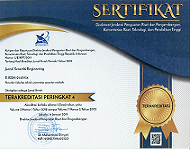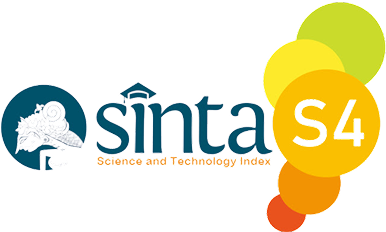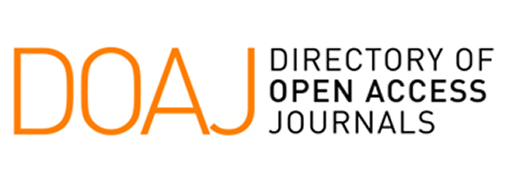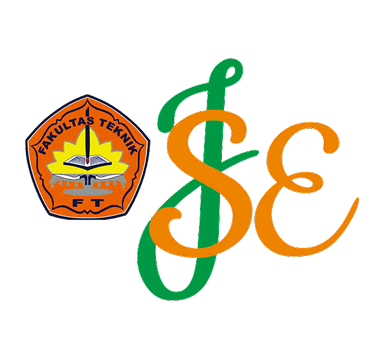Potential Study of Hazardous Waste Sludge Recycle for Substituting the Supporting Raw Material in Fertilizer Manufacturing
Keywords:
wwtp sludge, npk fertilizer, filler substitution, sludge characterization, cost savingAbstract
Waste water treatment facilities (WWTP) are producing a rising amount of sludge, which poses serious disposal and environmental issues. The purpose of this study is to investigate the possibility of using WWTP sludge in place of filler materials while making NPK fertilizer. Significant levels of vital elements, including nitrogen (N), phosphorous (P), and potassium (K), which are crucial for fertilizer quality, were found in the sludge after a thorough physical and chemical analysis. A comparative assessment was performed between the WWTP sludge and standard clay filler materials to evaluate compliance with Indonesian National Standard (SNI) 2803:2024 for solid NPK fertilizers. Experimental mixing trials identified the optimal sludge-to-clay ratio as 60:40, which produced fertilizer granules with acceptable physical properties, homogeneity, and nutrient content that met the SNI requirements. This study shows that using WWTP sludge as a filler in fertilizer manufacture has major financial advantages in addition to supporting resource recovery and sustainable waste management. The study promotes the use of sewage reuse in fertilizer production as a creative way to solve environmental issues and boost industrial productivity.
References
[1] M. G. Setiawan, S. O. Suryani, H. R. SuhExist, S. Wibowo, and A. Hartono, “Optimalisasi Subsidi Pupuk untuk Mendukung Ketahanan Pangan Nasional,” Policy Brief Pertanian, Kelautan, dan Biosains Tropika, vol. 6, no. 4, pp. 1077–1083, 2024, doi: 10.29244/agro-maritim.0604.1077-1083.
[2] L. Fiamelda, Suprihatin, and Purwoko, “Analysis of water and electricity consumption of urea fertilizer industry: Case study PT. X,” IOP Conf Ser Earth Environ Sci, vol. 472, no. 1, 2020, doi: 10.1088/1755-1315/472/1/012034.
[3] A. T. Azalia, “Wastewater Treatment of Npk Fertilizer Industry Using Sequencing Batch Reactor and Granular Activated Carbon,” Journal of Enviromental Engineering and Sustainable Technology, vol. 9, no. 2, pp. 83–90, 2022, doi: 10.21776/ub.jeest.2022.009.02.6.
[4] M. F. Seleiman, A. Santanen, and P. S. A. Mäkelä, “Recycling sludge on cropland as fertilizer – Advantages and risks,” Resour Conserv Recycl, vol. 155, 2020, doi: 10.1016/j.resconrec.2019.104647.
[5] F. K. Atmadja, W. H. Febrilla, and T. Widjaja, “Pra-Desain Pabrik Pupuk NPK dari DAP, ZA, dan KCL dengan Metode Mixed Acid Route Berkapasitas 500.000 Ton/Tahun,” Jurnal Teknik ITS, vol. 10, no. 2, pp. 216–221, 2021, doi: 10.12962/j23373539.v10i2.71887.
[6] D. Pramono, D. Natawijaya, and S. Suhardjadinata, “Pengaruh Jenis Pupuk Organik dan Pupuk NPK TerhExistp Pertumbuhan dan Hasil Kedelai Edamame (Glycine max L. Merril),” Media Pertanian, vol. 8, no. 2, pp. 59–71, 2023, doi: 10.37058/mp.v8i2.8353.
[7] F. N. Ariestiyani and Moch. T. Safirin, “Analysis of Phonska Fertilizer Product Quality Control Using Seven Tools Method With Fmea: A Case Study,” Journal La Multiapp, vol. 6, no. 1, pp. 58–78, 2025, doi: 10.37899/journallamultiapp.v6i1.1850.
[8] NKENDE, Mineral fertilizer production and the environment. Part 1, The fertilizer industry’s manufacturing processes and environmental issues. 1998.
[9] U. N. I. D. O. (UNIDO) and I. F. D. C. (IFDC), “Fertilizer Manual.pdf,” 1998.
[10] MLHK, “Peraturan Menteri Lingkungan Hidup Dan Kehutanan Republik Indonesia Nomor 6 Tahun 2021 Tentang Tata Cara dan Persyaratan Pengelolaan Limbah Bahan Berbahaya Dan Beracun,” Menteri Lingkungan Hidup Dan Kehutanan Republik Indonesia, no. April, pp. 5–24, 2021.
[11] D. Olejnik, “Evaluation of the Heavy Metals Content in Sewage Sludge from Selected Rural and Urban Wastewater Treatment Plants in Poland in Terms of Its Suitability for Agricultural Use,” Sustainability (Switzerland) , vol. 16, no. 12, 2024, doi: 10.3390/su16125198.
[12] G. Tassinari, S. Boccaletti, and C. Soregaroli, “Recycling sludge in agriculture? Assessing sustainability of nutrient recovery in Italy,” European Review of Agricultural Economics, vol. 50, no. 5, pp. 1633–1658, 2023, doi: 10.1093/erae/jbad035.
[13] M. R. Syahputra, I. H. Rambe, D. Mathelinea, and H. Mawengkang, “Mathematical Modelling of Engineering Problems Modelling an Integrated Approach to Optimize the Disposal of Industrial Hazardous Waste While Prioritizing Sustainability,” vol. 12, no. 5, pp. 1751–1760, 2025.
[14] T. Turlej and M. Banaś, “Management of hazardous waste in Poland,” International Multidisciplinary Scientific GeoConference Surveying Geology and Mining Ecology Management, SGEM, vol. 18, no. 1.5, pp. 337–344, 2018, doi: 10.5593/sgem2018v/1.5/s02.042.
[15] Muharam, A. Lestari, and Solahudin, “Pemanfaatan Limbah Sludge Industri Kertas Menjadi Pupuk Organik Sebagai Suatu Upaya Penanggulangan Pencemaran Lingkungan dan Pengembangan Ekonomi Budidaya Kembang Kol (Brassica Oleraceal.) di Kecamatan Rawamerta Kabupaten Karawang,” Jurnal Pengabdian Masyarakat, vol. 5, no. 1, pp. 45–49, 2022, [Online]. Available: https://jurnalpertanianunisapalu.com/
Downloads
Published
Issue
Section
License
Copyright (c) 2025 Saraswati Sinti Awidi, Temmy Wikaningrum (Author)

This work is licensed under a Creative Commons Attribution 4.0 International License.












